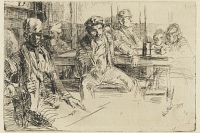Etchings Institutions search term: thibaudeau
Longshore men | ||
| Number: | 52 | |
| Date: | 1859 | |
| Medium: | etching and drypoint | |
| Size: | 153 x 225 mm | |
| Signed: | 'Whistler - ' at lower right | |
| Inscribed: | '1859 -' at lower right | |
| Set/Publication: | no | |
| No. of States: | 4 | |
| Known impressions: | 37 | |
| Catalogues: | K.45; M.44; T.45; W.43 | |
| Impressions taken from this plate (37) | ||
TECHNIQUE
It was drawn vigorously with patches of rough cross-hatching, scrawly zig-zags, and curved lines delineating rounded surfaces. The lines of the wooden bench go through the left arm of the man in the foreground, showing that he was drawn after the bench (but that these lines were partly removed or stopped-out before the plate was printed). The faces of the woman and child are mask-like, with patches of shading crossing the principal planes, like the eyes and cheeks. There is fine drypoint shading on and around the central man's right eye and on the cheek below it, and curved drypoint lines on the left sleeve of the leftmost man, which fade in late impressions.
PRINTING
It was printed in comparatively large numbers, considering that it was not published. Over forty impressions have been recorded.
Impressions of the first ( ) and second (
) and second ( ) state were printed in black ink on ivory 'antique' (pre-1800) laid paper.
Most impressions of the third state were printed in black ink, on a variety of papers including buff (
) state were printed in black ink on ivory 'antique' (pre-1800) laid paper.
Most impressions of the third state were printed in black ink, on a variety of papers including buff ( ); grey wove (
); grey wove ( ); and cream 'modern' (post-1800) laid (
); and cream 'modern' (post-1800) laid ( ); off-white laid (
); off-white laid ( ); cream laid paper taken from a book (
); cream laid paper taken from a book ( ) and an unusual pale blue 'antique' laid paper (
) and an unusual pale blue 'antique' laid paper ( ). Quite a large proportion are on Asian papers, mostly cream Japanese (
). Quite a large proportion are on Asian papers, mostly cream Japanese ( ,
,  ,
,  ), and ivory Japan (
), and ivory Japan ( ). Some of these impressions may have been printed and sold in the 1870s (
). Some of these impressions may have been printed and sold in the 1870s ( ,
,  ).
).
 ) and second (
) and second ( ) state were printed in black ink on ivory 'antique' (pre-1800) laid paper.
Most impressions of the third state were printed in black ink, on a variety of papers including buff (
) state were printed in black ink on ivory 'antique' (pre-1800) laid paper.
Most impressions of the third state were printed in black ink, on a variety of papers including buff ( ); grey wove (
); grey wove ( ); and cream 'modern' (post-1800) laid (
); and cream 'modern' (post-1800) laid ( ); off-white laid (
); off-white laid ( ); cream laid paper taken from a book (
); cream laid paper taken from a book ( ) and an unusual pale blue 'antique' laid paper (
) and an unusual pale blue 'antique' laid paper ( ). Quite a large proportion are on Asian papers, mostly cream Japanese (
). Quite a large proportion are on Asian papers, mostly cream Japanese ( ,
,  ,
,  ), and ivory Japan (
), and ivory Japan ( ). Some of these impressions may have been printed and sold in the 1870s (
). Some of these impressions may have been printed and sold in the 1870s ( ,
,  ).
).
The final state was usually printed in black ink, again on a variety of papers including grey chine appliqué ( ); cream or ivory Japanese (
); cream or ivory Japanese ( ,
,  ,
,  ) and cream Asian laid paper (
) and cream Asian laid paper ( ). A few impressions were printed in dark brown ink on greenish 'modern' laid paper (
). A few impressions were printed in dark brown ink on greenish 'modern' laid paper ( ,
,  ). Some of these were probably printed in the 1890s or after Whistler's death, possibly for the New York print dealer Frederick Keppel (1845-1912) (
). Some of these were probably printed in the 1890s or after Whistler's death, possibly for the New York print dealer Frederick Keppel (1845-1912) ( ,
,  ).
).
 ); cream or ivory Japanese (
); cream or ivory Japanese ( ,
,  ,
,  ) and cream Asian laid paper (
) and cream Asian laid paper ( ). A few impressions were printed in dark brown ink on greenish 'modern' laid paper (
). A few impressions were printed in dark brown ink on greenish 'modern' laid paper ( ,
,  ). Some of these were probably printed in the 1890s or after Whistler's death, possibly for the New York print dealer Frederick Keppel (1845-1912) (
). Some of these were probably printed in the 1890s or after Whistler's death, possibly for the New York print dealer Frederick Keppel (1845-1912) ( ,
,  ).
).
